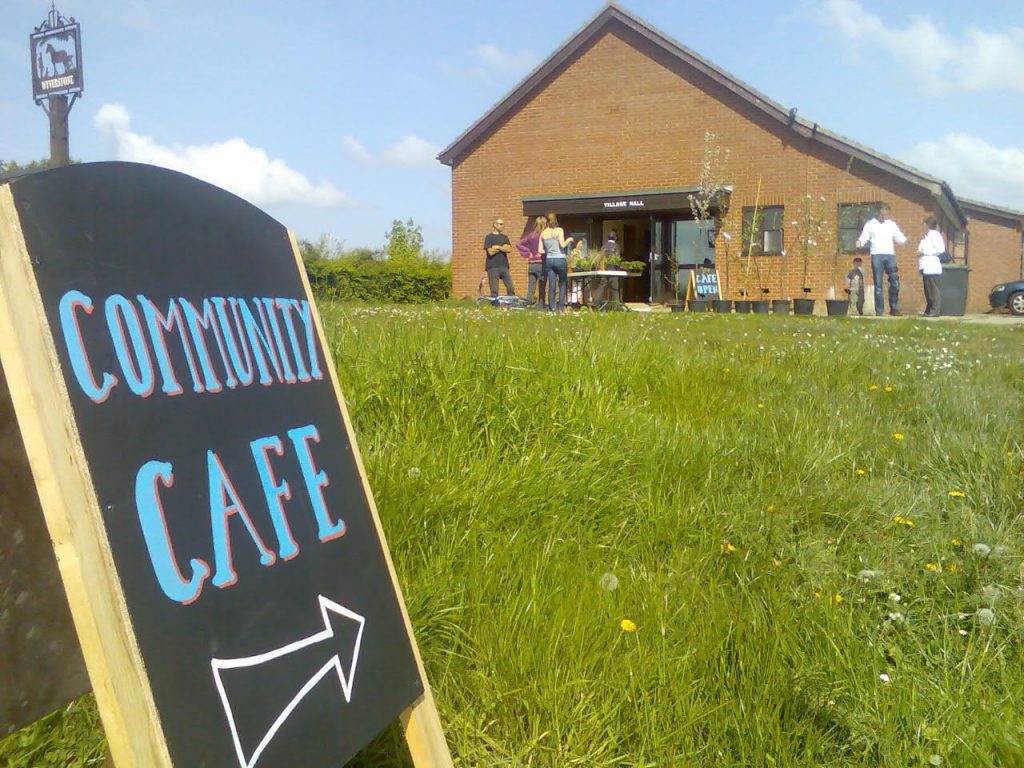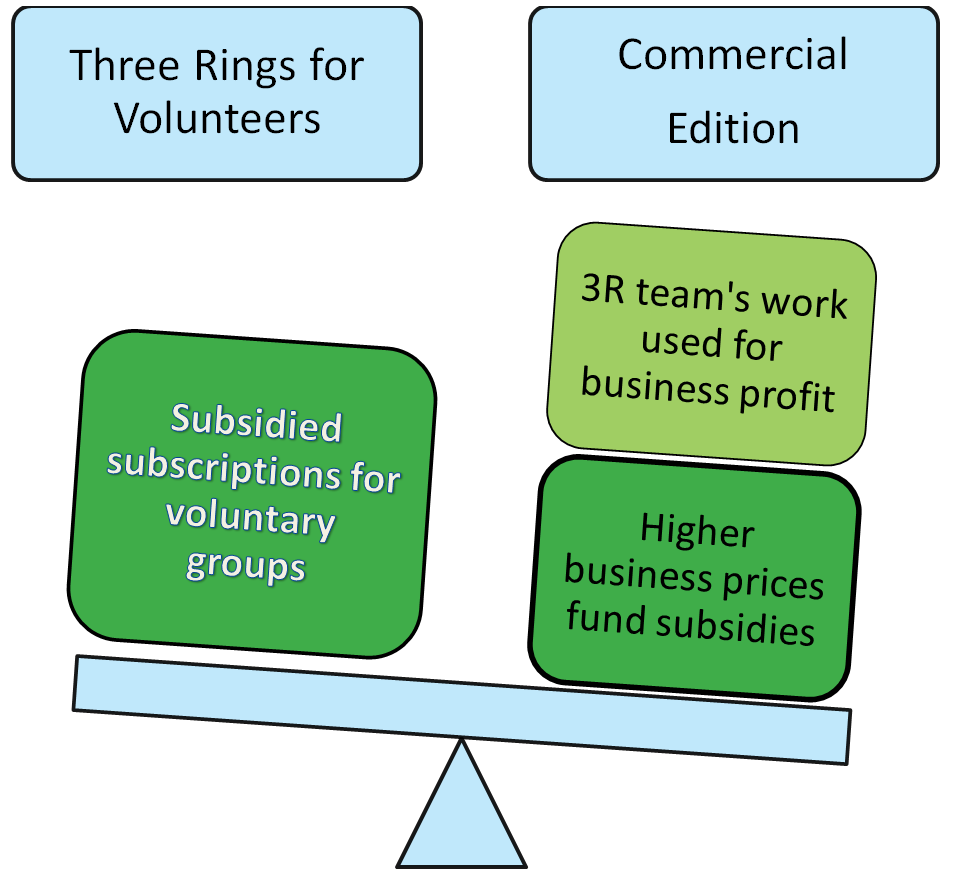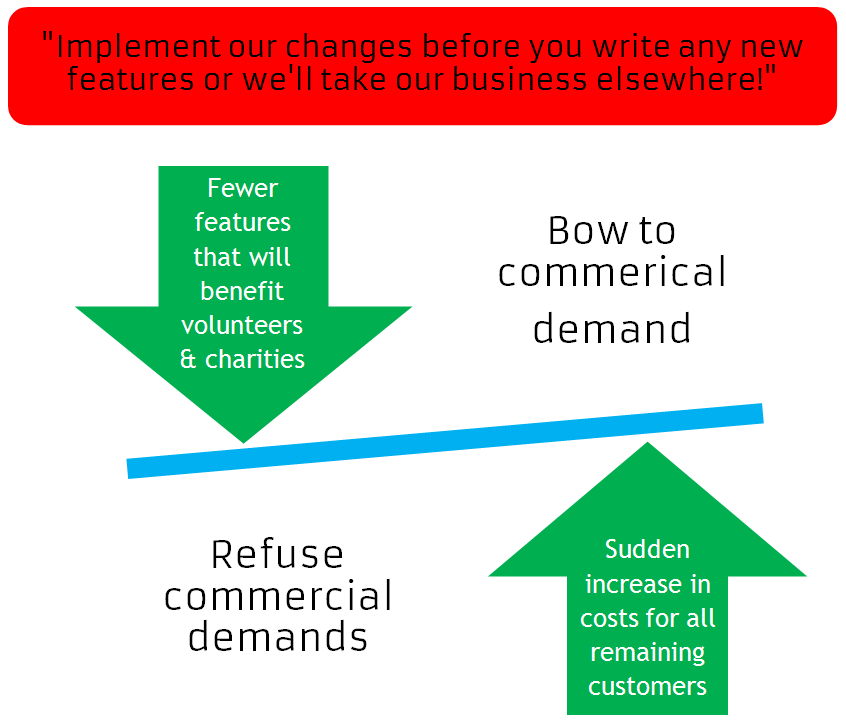This is the second part of a two-part blog post. The first part is here.
As we saw last week, there’s lots of reasons why a business would want to take advantage of systems like Three Rings to manage their employees: there’s a huge business need out there, and although plenty of commercial services exist to meet that need, the fact that we aim to sell to social enterprises means we deliver incredible value. But when business ask to start using Three Rings, we tell them we can’t help. Why is that?
What’s the problem with us selling to big businesses?
We began to explain last week that the biggest thing stopping us wanting to offer Three Rings to for-profit companies is that we’re a not-for-profit company, run entirely by volunteers.
Our team give up their time and their expertise to develop and support Three Rings so that our customers can reap the rewards – and we don’t have a problem with that: we want to make life easier for charities and voluntary organisations!
But we’re less keen to give our time and energy for free in order to help someone else make lots of money.
Right now, all our clients exist to help people in one way or another, and we’re happy to support them: knowing we’re helping is all the reward we need.
If we started taking on private enterprises as customers we’d be asking our volunteers to give their skills to help line someone else’s pocket, and that’s not at all fair on them (it’s especially not fair on our developers: some of them are worth quite a lot of money as freelance software engineers in their own right!).

And, of course, because Three Rings CIC is a not-for-profit company, run by volunteers, there’s a limit to how much use “more money” we need. Of course we have expenses – so do all companies! – but we work hard to keep those costs low. Partly, we do this by using the sorts of trusted, open-source technologies favoured by tech giants like Google, Amazon and Twitter. That, combined with the scalable nature of Three Rings itself means we don’t run the risk of spending customer money on expensive third-party software to keep the system going.
After our running costs are met – including the annual Christmas Card! – any profit the company makes gets donated to charities (plus some to support the kinds of open-source technology projects that make Three Rings possible: charities are nominated by our own volunteers, and we’ll be explaining more about this process soon, too).
It would be lovely to be able to give more, but doing so doesn’t directly help either Three Rings or the organisations we support, so there isn’t a particular incentive for us to take on rich businesses as clients – especially since that would be a major conflict with our core value of being a volunteer-focused organisation in our own right!
How could we make that less of a problem?
But there is one way in which having more money could be really useful: we could offer a higher subscription charge for a ‘Commercial Edition’ of Three Rings, and use the income from that to subsidise all of our existing clients! The business would get the system they wanted, and everybody else would get Three Rings for a lower cost, safeguarding even more of their budget.
Under this system, everyone’s a winner: businesses would get to use Three Rings to help maximise their efficiency, so they’re happy. Our not-for-profit customers would have their subscriptions to Three Rings subsidised by the businesses using the system on a Commercial Edition pricing plan, so they save money, and are happy. And our volunteers would be giving their time and expertise in a way that helps businesses turn a profit, but can offset that because they know that by doing so they’re also saving our volunteer organisations money, and they’re happy too.

Although all of our team are professionals whose motivation for giving their time and skills to Three Rings is anything but making lots of money from it, it’s possible we might not mind using our volunteers’ unpaid efforts to maximise a business’s profits if we could use higher “commercial” subscription rates to subsidise the cost to our voluntary organisations – as long as the balance doesn’t shift.
And to some people, this seems like it would be a really great way to strike a balance that suits everyone: it’s pretty clearly a win-win! Only…
Why isn’t that solution good enough?
There’s a big problem with that solution. Although it looks good on the surface, the “balanced” model above would introduce a serious vulnerability: the even-lower cost to our regular not-for-profit organisations would be completely dependent on retaining Commercial Edition clients.
If we went down that route, and then a major for-profit company suddenly decided to cancel their Three Rings subscription, there’d be no “Higher business prices fund subsidies” under the Commercial Edition side of the balance. In effect, we’d be holding ourselves hostage, dependent on keeping our Commercial clients at all costs.
We’ve described our feature planning process before and, with the exception of ‘Best Tester’ features that get to jump the queue as a thank you to our volunteer test team for helping to make Three Rings better, we plan new features based on what will help the largest number of people. With a steady stream of users getting in touch to suggest new ways Three Rings could help them, that’s the best way for us to keep the system evolving in a way that’s fair to everyone.
Right now, that works fine, and everyone knows where they stand. But if we adopted that model, and then a business wanted a feature that would only help them, we’d have a problem.
All our regular customers could be clamouring for a great new feature, but what if a Commercial Edition customer demanded we introduce a complicated Purchase Order Tracking System, and threatened to drop their subscription if we didn’t?

With day jobs on top of their Three Rings work, our volunteers simply couldn’t satisfy both demands, so they’d be in a difficult position: either let down our primary user group by prioritising the commercial feature ahead of what they need, instead of working on new features that could help lots more people…or else disappoint the Commerical Edition customer, leaving them to come good on their threat and drop Three Rings entirely.
If the Commercial Edition customer did just up and leave, we’d lose the extra revenue we’d been using to subsidise our social enterprise customers. The see-saw would give a sudden lurch the other way and everybody would suddenly face an unexpected jump in their subscription rates!
Now, it’s important to remember that we’ve just described a ‘worst-case’ scenario – perhaps the hypothetical business customer would decide they could live without that feature after all – but it’s a risk we don’t feel we can take: too many people rely on Three Rings for us to be able to gamble with the quality of service we’ve committed to delivering.
So what does that mean for Three Rings?
Years ago, we looked at all those points – the positives, the negatives, the various risks and pitfalls they opened up – and we decided we had to say “no” to any big businesses that came along: the benefits weren’t worth the risk.
More than that, the benefits were barely worth the benefits: compared to other enterprise software, Three Rings offers incredible value for money as it is!
So Three Rings CIC doesn’t do business with Big Business. We aren’t here to help the corporate world make more money, and we’re not here to make lots of money ourselves.
What we’re here for is to help and support charities and social enterprises, businesses that exist to meet a social goal, not just to create profit. That’s what our volunteers are giving their time to do.
That’s why we turn major businesses away when they ask if they can start using Three Rings. Because we’re guided by our core values, using our efforts to deliver enterprise-grade software at the best prices we can offer, to bring volunteers together around the world.
